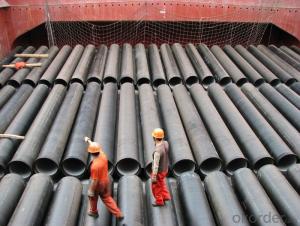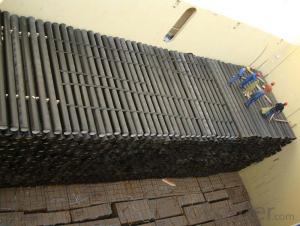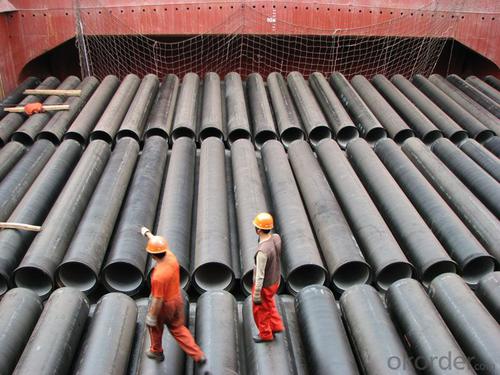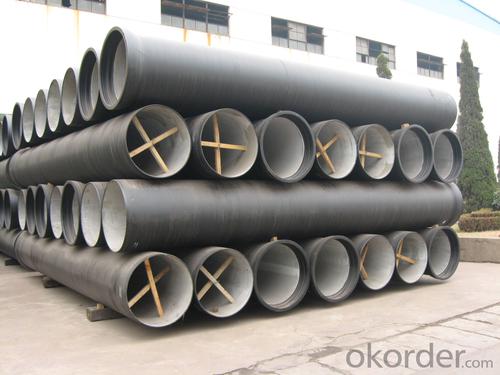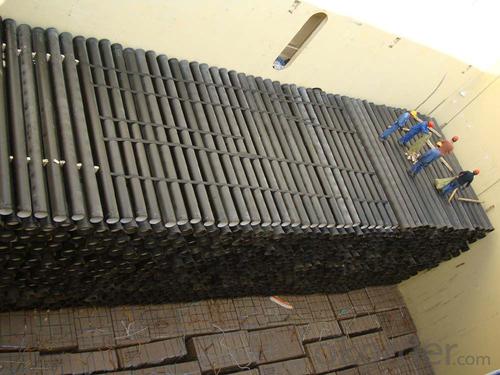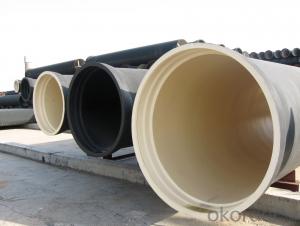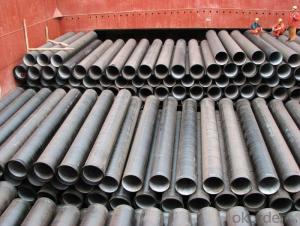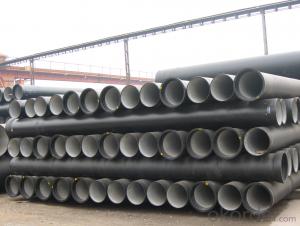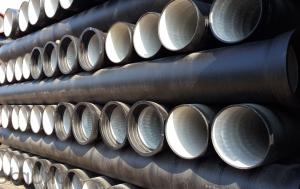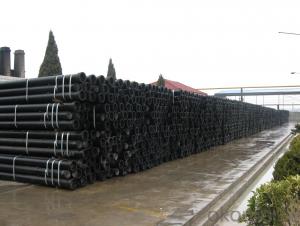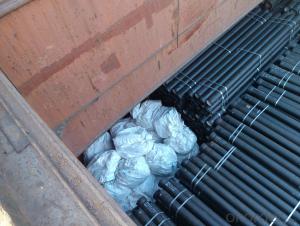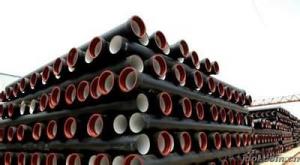DUCTILE IRON PIPE DN80 K9/C/K8
- Loading Port:
- China Main Port
- Payment Terms:
- TT OR LC
- Min Order Qty:
- -
- Supply Capability:
- -
OKorder Service Pledge
OKorder Financial Service
You Might Also Like
Specification:
1) The standard of pipe: ISO2531:1998, K9
2) Effective length: 6m
3) Inner cement line: Portland cement line as per ISO4179
4) Zinc coating: at least 130g/m2 as per ISO8179
5) Bitumen painting: at least 70um as per ISO8179
6) With 100% quantity of NBR ring, or SBR ring, or EPDM ring as per ISO4633
7) DN80mm-800mm
8) High strength, lighter than grey iron, good corrosion resistance, no furring, small flow resistance, easy fixing, long life tome about 100 yeas
9) Produced by Hangzhou chunfeng machine
10) Checked by automatic inspection equipment
11) Composition:
Chemical composition | | | | |||
Chemical composition | Ductile Cast Iron Pipe (%) | Grey iron pipe (%) | Steel pipe (%) | | | |
C | 3.5-4.0 | 3.2-3.8 | 0.1-0.2 | | | |
Si | 1.9-2.6 | 1.4-2.2 | 0.15-0.4 | | | |
Mn | 0.15-0.45 | 0.4-0.6 | 0.3-0.6 | | | |
P | ≤0.06 | ≤0.3 | 0.02-0.03 | | | |
S | ≤0.02 | ≤0.1 | 0.02-0.03 | | | |
Mg | 0.03-0.06 |
|
| | | |
12) Feature:
Mechanical properties | | | | |||
| Ductile Cast Iron Pipe | Grey Iron Pipe | Steel Pipe | | | |
Tensile Strength(Mpa) | ≥420 | 150-260 | ≥400 | | | |
Yield Strength(Mpa) | ≥300 | No Confirmation | No Confirmation | | | |
Bending Strength(Mpa) | ≥590 | 200-360 | ≥400 | | | |
Elongation (%) | ≥10 | Neglected | ≥18 | | | |
Brinell Hardness(HBS) | ≤230 | ≤230 | About 140 | | | |
13) T type mechanical joint
14) Packing: in bulk or container
- Q: How does ductile iron pipe handle temperature changes?
- Ductile iron pipe is known for its ability to handle temperature changes effectively. The unique properties of ductile iron make it highly resistant to thermal expansion and contraction, allowing it to withstand extreme temperature variations without significant deformations or failures. When exposed to temperature changes, ductile iron pipes can expand or contract within certain limits due to its inherent ductility. This flexibility helps to accommodate thermal stresses and prevent the pipe from cracking or breaking. The material's high tensile strength and elasticity also contribute to its ability to handle temperature changes without significant structural damage. Moreover, ductile iron pipes have a low coefficient of thermal expansion, meaning they expand and contract at a relatively slow rate compared to other materials. This characteristic minimizes the potential for stress on the pipe joints and reduces the risk of leaks or failures. In addition to its excellent thermal stability, ductile iron pipe also features a protective lining that further enhances its resistance to temperature changes. The linings, such as cement mortar or polyethylene, create a barrier between the pipe and the transported fluid, preventing any adverse effects caused by thermal variations on the pipe's internal surface. Overall, ductile iron pipe is a reliable choice for applications where temperature changes are common. Its ability to withstand thermal stresses, low coefficient of thermal expansion, and protective linings make it a durable and efficient solution for various infrastructural needs, including water distribution, wastewater management, and industrial applications.
- Q: What is the average weight of ductile iron pipes?
- The average weight of ductile iron pipes varies depending on their size and specifications. Generally, ductile iron pipes can range in weight from a few hundred pounds to several tons per linear foot.
- Q: Can ductile iron pipes be used for irrigation systems?
- Yes, ductile iron pipes can be used for irrigation systems. Ductile iron pipes are commonly used in various applications, including water supply systems and irrigation systems. They are known for their strength, durability, and corrosion resistance, making them suitable for transporting water in irrigation systems.
- Q: What is the expected cyclic fatigue life of ductile iron pipes?
- The expected cyclic fatigue life of ductile iron pipes can vary depending on several factors such as material composition, pipe design, loading conditions, and environmental factors. However, ductile iron pipes are generally known for their excellent fatigue resistance. Ductile iron pipes are designed to withstand cyclic loading, which is commonly experienced in water distribution and sewer systems due to fluctuating pressures and vibrations. These pipes have a unique microstructure that provides high strength and ductility, allowing them to resist the formation and growth of cracks under cyclic loading. Several studies and industry standards have provided estimates for the expected cyclic fatigue life of ductile iron pipes. The American Water Works Association (AWWA) C151 standard, for example, recommends a design life of 100 years for ductile iron pipes used in water distribution systems, indicating their long-term durability and fatigue resistance. Furthermore, research studies have shown that ductile iron pipes can withstand over 1 million cycles of loading without any signs of fatigue failure. The fatigue strength of ductile iron pipes can be further enhanced by using protective coatings or linings to minimize the effects of corrosion and abrasion. However, it is important to note that the expected cyclic fatigue life of ductile iron pipes can be influenced by various factors such as the quality of manufacturing, installation practices, and maintenance procedures. Regular inspections, proper handling, and adherence to recommended installation guidelines can help ensure the longevity and performance of ductile iron pipes. In summary, while the expected cyclic fatigue life of ductile iron pipes can vary depending on several factors, these pipes are generally known for their excellent fatigue resistance and can provide a long-term and reliable solution for water distribution and sewer systems.
- Q: What does ductile iron pipe "K" mean?
- 1 、 pipe fittings are K type, T type, etc.;2 wall thickness registration symbol. For example, according to the pipe quality standards GB/T13295-K9, which is the wall thickness ofK=9* (DN/1000+0.5)
- Q: What are the typical bedding and backfill requirements for ductile iron pipes?
- The typical bedding and backfill requirements for ductile iron pipes are important to ensure the proper installation and long-term performance of the pipes. Generally, the bedding material should be a granular material that provides support and uniform load distribution to the pipe. This can include materials such as sand, gravel, or crushed stone. The bedding material should be placed in a continuous and uniform layer along the bottom of the trench, with a minimum thickness of 6 inches. The width of the bedding layer should be at least 1.5 times the outside diameter of the pipe, or as specified by the pipe manufacturer. Backfill material is used to fill the remaining space around the pipe after the bedding is in place. The backfill material should also be a granular material, free from large stones, debris, or organic matter. It should be compacted in layers around the pipe, typically in 6-inch increments, using appropriate compaction equipment. The backfill should be placed evenly around the pipe, ensuring that there are no voids or gaps. It is important to avoid excessive compaction that could lead to damage or deformation of the pipe. The backfill material should extend above the top of the pipe to provide a minimum of 12 inches of cover. In addition to the bedding and backfill requirements, it is essential to follow any specific guidelines provided by the pipe manufacturer. These guidelines may include recommendations for specific materials, compaction methods, or additional protective measures. Overall, the proper bedding and backfilling of ductile iron pipes is crucial for maintaining the structural integrity and preventing damage or failure of the pipe system. Adhering to industry standards and manufacturer specifications ensures the longevity and performance of the pipes in various applications.
- Q: Can ductile iron pipes be used in dam or reservoir projects?
- Yes, ductile iron pipes can be used in dam or reservoir projects. Ductile iron pipes are known for their durability, strength, and corrosion resistance, making them suitable for various applications, including water supply systems in dams and reservoirs. Additionally, their ability to withstand high pressure and adapt to ground movement makes them a reliable choice for such projects.
- Q: Can ductile iron pipes be used in areas with high soil erosion?
- Due to their inherent strength and durability, ductile iron pipes can be utilized in regions with substantial soil erosion. Ductile iron, a type of iron treated with graphite nodules, enhances its flexibility and tensile strength, rendering it highly resistant to cracking and breaking, even in extreme conditions. In areas with high soil erosion, the ground tends to shift and move, imposing significant stress on underground pipes. Nevertheless, ductile iron pipes exhibit high resistance to external loading and can endure the pressures exerted by the surrounding soil. Their reliability in such environments has been extensively tested and proven. Moreover, ductile iron pipes boast a lengthy lifespan, often exceeding 100 years, making them a cost-effective choice for areas with substantial soil erosion. Their corrosion resistance and structural integrity render them suitable for installation in diverse soil conditions, including those susceptible to erosion. It is crucial to note that proper installation techniques, like employing appropriate bedding and backfill materials, must be adhered to in order to ensure the optimal performance of ductile iron pipes in areas with high soil erosion. Additionally, regular inspection and maintenance should be carried out to promptly identify any potential issues and prevent damage resulting from soil erosion. All in all, ductile iron pipes serve as a dependable and durable option for regions with high soil erosion, providing enduring and efficient water distribution and wastewater management systems.
- Q: Can ductile iron pipes be used in areas with high levels of groundwater contamination?
- Areas with high levels of groundwater contamination can make use of ductile iron pipes. Ductile iron, known for its strength and durability, is resistant to corrosion, making it suitable for various environments, including those with contaminated groundwater. It provides a high level of resistance to chemicals and can withstand the corrosive effects of contaminants that may be present in the groundwater. Furthermore, ductile iron pipes possess a protective lining, further enhancing their corrosion resistance. However, it is important to consider that the suitability of ductile iron pipes in such areas relies on the specific nature and concentration of contaminants in the groundwater. Seeking advice from experts and adhering to local regulations and industry standards is essential to ensure the proper selection and installation of pipes in areas with high levels of groundwater contamination.
- Q: Are ductile iron pipes resistant to sulfuric acid corrosion?
- Yes, ductile iron pipes are generally resistant to sulfuric acid corrosion. Ductile iron is a strong and durable material that contains a high percentage of iron, making it less susceptible to the corrosive effects of sulfuric acid compared to other materials like cast iron or steel. However, it is important to note that the level of resistance can vary depending on factors such as the concentration and temperature of the sulfuric acid, as well as the duration of exposure. In highly concentrated or elevated temperature environments, additional protective measures such as lining the pipes with suitable materials or employing corrosion inhibitors may be necessary to ensure long-term resistance to sulfuric acid corrosion.
Send your message to us
DUCTILE IRON PIPE DN80 K9/C/K8
- Loading Port:
- China Main Port
- Payment Terms:
- TT OR LC
- Min Order Qty:
- -
- Supply Capability:
- -
OKorder Service Pledge
OKorder Financial Service
Similar products
Hot products
Hot Searches
Related keywords
